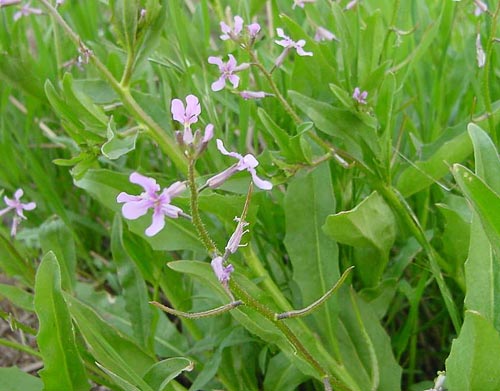Weeds
Chorispora tenella (Pall.) DC. - Blue Mustard, Crossflower
Systematic position.
Family Brassicaceae Burnett (Cruciferae Juss.), genus Chorispora DC.Synonyms.
Raphanus tenellus Pall.Biological group.
Winter or early spring annual weed.Morphology and biology.
Plant is 5-30 cm tall. Root system consists of a stout taproot. Stems are prostrate or ascending, branched, covered with small glandular and plain hairs. Leaves are tegouolar, oblong, lower leaves are from sinuate-serrate to pinnatilobate and pinnatipartite in shape; stem leaves are more or less serrate or almost entire. Inflorescence is loose raceme elongating at the end of blossoming. Flowers are bulging, incrassate. Sepals are usually bluish-colored, glandular-haired and oblong. Petals are entire, light purple, twice as long as calyx. Fruit is silicle, thinly cylindrical, more or less curved, bulging, knobby, covered with sparse glandular hairs and elongated upwards into subulate beak. When ripe, silicle divides into 2 rows of one-seeded prismatic segments. Segments are linear-grooved, with several more prominent ribs, convex in the middle, rugous. Seeds are yellowish-brown, flattened and often germinate while still in the segments. This plant flowers in March-April; bears fruits in April-May.Distribution.
Within European part of the Former Soviet Union - Black Sea coast, Crimea, the Caucasus, lower reaches of Don and Volga rivers; southern part of Western Siberia, Central Asia. General distribution: Balkan Peninsula, Asia Minor, Iran, Mongolia, north-western China, northern India.Ecology.
It is a plant of clay and solonetzic steppes and ephemeral herbage of semi-deserts. Chorispora tenella prefers desolate habitats and it helps to stabilize their disturbed soil. This plant prefers to grow in full sun and can tolerate dry conditions. It also tolerates different kinds of soil, but it is more commonly found in poor soils that contain clay or gravel because of the reduced competition from other plants.Economic significance.
This weed infests different crops, especially winter wheat and alfalfa. It also occurs near fences, houses, roads, along banks of canals and aryks. Leaves are edible and it is possible to use them in salad. When Chorispora tenella is fed to cattle it can cause distasteful milk with a disagreeable odor. Control measures include: autumn plowing and pre-sowing soil treatment, harrowing of winter crops, rotation of winter and cereal crops in the fields.Reference citations:
Hilty J. 2003-2005. Illinois Wild Flowers - Blue Mustard. Illinois Wild Flowers: http://illinoiswildflowers.info/weeds/plants/blue_mustard.htmKeller B.A., ed. 1934. Weed plants of the USSR. V. 3. Leningrad: AN SSSR. 448 p. (In Russian)
Komarov, V.L. & N.A. Bush, eds. 1939. Flora of the USSR. V. 8. Moscow-Leningrad: AN SSSR. 696 p. (In Russian)
Nikitin V.V. 1983. Weed plants of the USSR flora. Leningrad: Nauka. 454 p. (In Russian)
Pokorney G. 2004. Blue Mustard. University of Idaho: http://cnr.uidaho.edu/range454/2004%20pet%20weeds/bluemustard.html
Vasilchenko I.T., Pidotti O.A. 1975. Identification book on weed plants of regions of irrigated agriculture. Leningrad: Kolos. 376 p. (In Russian)
Visyulina O.D., ed. 1970. Weeds of Ukraine (reference-identification guide). Kiev: Naukova Dumka. 508 p. (In Ukrainian)


